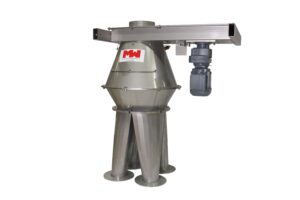RTS Product Brochure.

To find out more about our Rotary Tube Splitter (RTS) please feel free to
download product brochure:
The Rotary Tube Splitter (RTS) is designed for representative splitting of bulk material. The material is split evenly between a number of sample outlets.
Variant 1 (standard): The Rotary Tube Splitter (RTS-2) has two sample outlets in the bottom section.
Variant 2: The Rotary Tube Splitter (RTS-3) has three sample outlets in the bottom section.
Variant 3: The Rotary Tube Splitter (RTS-4) has four sample outlets in the bottom section.
The Rotary Tube Splitter (RTS):

To find out more about our Rotary Tube Splitter (RTS) please feel free to
download product brochure:

The RTS consists of a drive unit, a rotating dividing pipe, a top cone with an inspection hatch, a rotation sensor, and a bottom cone with sample outlets. The motor unit is connected to a pulley that drives the timing belt and rotates the dividing pipe. The upper part of the dividing pipe is mounted on ball bearings.
The material is loaded into the upper part and ducted towards the periphery of the bottom cone’s inner wall, where the outlet slit geometry ensures a uniform split.
Options
1. The M&W central control cabinet can exchange signals with the client’s control system.
2. The RTS can be delivered with heat bearings on the lower cone.
3. The RTS can be delivered with an inner rubber coating in the housing of the unit to reduce the noise level.
Nota Bene 1
The splitter is typically used for splitting the material evenly by the division of two, three or four. To clarify, as opposed to the RTD the RTS does not have a reject outlet.